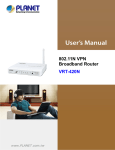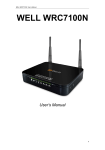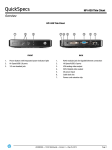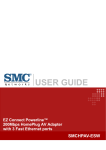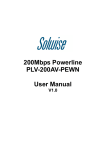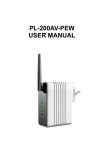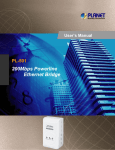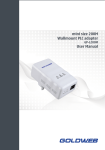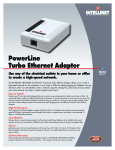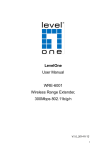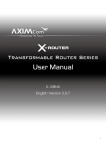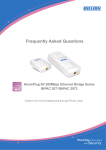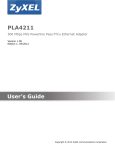Download Chapter 1 - LevelOne
Transcript
LevelOne PLI-3411 200Mbps Powerline Wireless Access Point User Manual V1.0 Safety Warnings 1. Do not use the adapter in high humidity or high temperature environment. 2. Do not open or repair the case yourself. 3. Avoid using this product and all its accessories outdoor. 4. Place PLI-3411 on a stable surface. 5. Plug your LevelOne PLI-3411 directly to the AC outlet on the wall. It is best to avoid using extension power cable as it may possess noise filter or surge protector functions that may cause interference that may impact the performance of the device. Table of Contents CHAPTER 1: PRODUCT .................................................................................................................................................................4 INTRODUCTION ...............................................................................................................................................................................4 Features .....................................................................................................................................................................................5 Specifications ..........................................................................................................................................................................6 CHAPTER 2: INSTALLING THE ADAPTER ................................................................................................................................7 Package Content .....................................................................................................................................................................7 Device Overview ......................................................................................................................................................................8 WPS configuration. ...............................................................................................................................................................11 Networking Setup ..................................................................................................................................................................12 Quick Start (Setup PowerLine Network).......................................................................................................................... 14 CHAPTER 3: BASIC NETWORK INSTALLATION ..................................................................................................................19 Network Configuration .........................................................................................................................................................20 Configuring with your Web Browser ................................................................................................................................24 CHAPTER 3: UTILITY INSTALLATION .....................................................................................................................................25 Utility Installation ..................................................................................................................................................................25 Configuration Utility Setup .................................................................................................................................................29 Main Tab ..................................................................................................................................................................................29 Privacy Screen .......................................................................................................................................................................32 Diagnostics Screen...............................................................................................................................................................33 About Screen..........................................................................................................................................................................35 CHAPTER 4: UI CONFIGURATION ............................................................................................................................................36 Setup .........................................................................................................................................................................................37 LOCAL AREA NETWORK (LAN) SETTINGS ...........................................................................................................................37 DHCP SERVER SETTINGS ..........................................................................................................................................................37 Wireless Settings ..................................................................................................................................................................38 WEP Settings..........................................................................................................................................................................41 WPA Pre-shared Key / WPA2 Pre-shared Key Settings ..............................................................................................41 WPA / WPA2 Radius Settings ............................................................................................................................................42 ADMIN – MANAGEMENT .............................................................................................................................................................47 Administration Interface Settings .....................................................................................................................................47 Reboot Settings .....................................................................................................................................................................47 Configuration Settings .........................................................................................................................................................48 Firmware Upgrade Settings ................................................................................................................................................48 Status – AP Status ................................................................................................................................................................49 Information Settings .............................................................................................................................................................49 LAN Settings .........................................................................................................................................................................50 Wireless Network 1 Settings ..............................................................................................................................................50 CHAPTER 5: TROUBLESHOOTING...........................................................................................................................................51 Troubleshooting Suggestions ...........................................................................................................................................51 Appendix: Product Support & Contact ............................................................................................................................52 DEFAULT SETTINGS IP Address User name Password Wireless Mode Wireless SSID 192.168.1.1 admin admin Enable LevelOne Chapter 1: Product Introduction Thank you for purchasing PLI-3411 200Mbps Powerline Wireless Access Point. Your new device is an unit that extends your wireless coverage through power lines. Compliant with the latest HomePlug AV standards, which support data speeds of up to 200Mbps, PLI-3411 can be used to 3 bridge Ethernet devices such as modems, routers, PCs, set-top- boxes, and game consoles, allowing users to share network access via existing in-home power cabling. What's unique is that the device has an extra built-in 802.11n Access Point, enabling users to enjoy mobility, high-speed wireless connection and better coverage with no more dead zones. Just plug PLI-3411 into any wall power socket, and you can easily set up a secure wireless network by pressing the Wi-Fi Protected Setup (WPS) button. Thus, the adapter can extend your wireless coverage through power lines for multimedia applications such as online games, IPTV and audio streaming from room to room. • Extended Wireless Coverage With an integrated 11n Wireless Access Point, the adapter can bridge wireless connections of up to 6 times the speed and 6 times the wireless coverage of an 802.11b / g network device. It supports a data rates up to 300Mbps and is also compatible with 802.11b / g equipment. • Noise-immune Transmission Unlike others, the device supports superior and noise-immune data transmission over in-home electrical power lines. Even at the moment your family turns on an electronic device or turns off a light, you won’t experience any interruption to latency-sensitive applications such as multimedia or video being shared with your family in another room. • 802.11g / 802.11n Wireless AP with WPA / WPS Support With an integrated 802.11g / 802.11n Wireless Access Point, the device The supported features of Wireless Protected Access (WPA-PSK/ WPA2-PSK) and Wireless Encryption Protocol (WEP) enhance the security level of data protection and access control via Wireless LAN. The device also supports the Wi-Fi Protected Setup (WPS) standard, allowing users to establish a secure wireless network by simply pushing a button. • Rich Management Interfaces Users can use WEB GUI through the above interfaces to configure and manage the device. • Web based GUI It supports web based GUI for configuration and management. It is user-friendly. • Firmware Upgradeable Device can be upgraded to the latest firmware through the WEB based GUI. 4 Features • Provides physical layer data rate of up to 200Mbps over existing in-home power lines • Extended wireless coverage of up to 3 times the range of 802.11g products • WPS (Wi-Fi Protected Setup) for easy setup • Auto channel select • Utilizes power line technology that takes advantage of the unused bandwidth of the electrical wiring in your home • Supports Triple Play applications such as IPTV, VoIP and high-speed Internet access • Supports 10/100 BaseT Ethernet • Compliant with the HomePlug PowerLine Alliance industry specifications • Ideal for residential users 5 Specifications Protocol TDMA, CSMA/CA Standard Ethernet specification: IEEE 802.3, IEEE 802.3x, IEEE 802.3u, Auto MDI/MDIX 200Mbps Transmission Speed Modulation Frequency Band Security Supports OFDM - 1155 carriers,1024 / 256 / 64 / 16 / 8 QAM, QPSK, BPSK and ROBO 2MHz ~ 30MHz 128-bit AES Link Encryption with key management for secure power line communications Encryption: NMK (Network Membership Key) used to authenticate/ access NET ID(Network ID) button Operating System Windows XP / Vista / 7 Other 10/100 Base-T Ethernet devices Power Supplier Input: 100~240V AC, 50~60Hz Physical Interface AC power plug 2 fixed antennas WPS button WIFI button NET ID button Reset button RJ-45 compatible LED display: • • • • • POWER WLAN WPS LAN1/LAN2/LAN3 PLC (PowerLine Link/Act) Physical Specifications Dimensions (W, D, H): 6.9 x 12 x 3.15 cm Operating Environment Operating temperature: 00C ~ 400C Storage temperature: -200C ~ 700C 6 Chapter 2: Installing the Adapter Package Content • PLI-3411 200Mbps Powerline Wireless Access Point • Quick Start Guide • CD (Manual/QIG/Utility) • RJ-45 Ethernet LAN Cable 7 Device Overview Front Panel The front panel contains lights called Light Emitting Diodes (LEDs) that indicate the status of the unit. Label Color Function POWER green On: device is powered on Off: device is powered off WLAN green On: WLAN link established and active Blink: Valid Wireless packet being transferred WPS green Off: WPS link isn’t established and active Blink: Valid WPS packet being transferred LAN 1/2/3 green On: LAN link established and active Off: No LAN link Blink: Valid Ethernet packet being transferred PLC green On: Powerline link established and active Off: No Powerline link Blink: Valid Powerline packet being transferred 8 Buttons There are WPS / WLAN / NET.ID / RESET buttons for different applications. Label Function ANTENNA ANTENNA POWER Connect the Powerline Ethernet Adapter to your wall-mounted power outlet. WLAN Press this button for at least two full second to turn off/on wireless signals WPS Press this button for at least three full seconds and the WPS LED will flash to start WPS. Now go to the wireless adapter or device and press its WPS button. Make sure to press the button within 120 seconds (2 minutes) after pressing the router's WPS button. If you are using a Wireless adapter connected to a computer, a "WPS Authentication" screen will appear. Wait until the screen says "Authentication succeeded." This may take a few minutes. LAN 1/2/3 Connects the device via Ethernet to up to 3 PCs on your LAN NET.ID The HomePlug AV powerline communication devices can form multiple logical networks over a common powerline or coax medium. There are many situations when it is desirable to add new devices to, or remove old devices from, a HomePlug AV logical network. Push this button to accomplish using HomePlug AV Simple Connect Technology. RESET Press this button for less than 2 seconds to start to reset the powerline settings to its default settings and reboot the device. Press this button for at least 6 full seconds to start to reset the device to its default settings. 9 Connecting the HomePlug Adapter It is easy to connect PLI-3411 simply by performing the following instructions: Power Connection Plug PLI-3411 into the wall outlet/socket. LAN & Wireless Connection Connect the supplied RJ-45 Ethernet cable to the Ethernet port on PLI-3411 and the other side to the device’s Ethernet interface. You can enable wireless function to connect to the Wi-Fi devices through WPS configuration interface or by pushing the WPS button of your PLI-3411. 10 WPS configuration. Keep pushing the WPS button of PLI-3411. Then push WPS button of your wireless IP device, and the Wi-Fi protection will be set up automatically. Likewise, do same steps for other wireless devices having WPS button. Example: Wireless IP Devices have WPS button PLI-3411 Push Push 1 Networking Setup Refer to the following steps: 1. Connect a network cable to the bridge and then plug PLI-3411 into a power socket. 2. Then connect PLI-3411 to a laptop, modem, router or a set-top-box. 12 3. Create a secure network by simply pushing the NET ID button for 1~3 seconds. Note: Plug/socket, power cable and input voltage/frequency may vary from country to country. 1 Quick Start (Setup PowerLine Network) Push Button usage NET ID Button is used to add a HomePlug device to a PowerLine network or enable it to join a network by pressing the NET ID Button of the device to turn it into Broadcast state or Join state. There are 4 types of NET ID Button trigger states: 1. Forming a Network Two devices with different network membership key (NMK) values are connected to the same powerline. The user wants them to form a logical network. 2. Joining a Network In this scenario a network exists. The user wants a new device, the ‘joiner’, to join the network. Any device on the existing network can become the ‘adder’. 3. Leaving a Network A network exists. The user wants to remove one device, the ‘leaver’, from that network, for whatever reason. He may want to remove the device from service altogether or have it join another logical network. 4. Join Multiple Devices to a Network Application Scenarios Scenario 1: Forming a Network Two devices with different network membership key (NMK) values are connected to the same powerline. The user wants them to form a logical network. A is 802.11n Powerline Ethernet Adaptor B is Atheros/Intellon solution Powerline Ethernet Adaptor 14 1. Press NET.ID (Network ID) button on A more than 10 seconds till PCL LED (ON for 1 seconds, then OFF for 2 seconds, then ON for 14 seconds) and then OFF to generate the random network password key first. 2. Press NET.ID (Network ID) button on B more than 10 seconds till all LEDs re-flash to generate the random network password key first. 3. Press NET.ID (Network ID) button on A for less than 3 seconds. 4. Press the button on B for less than 3 seconds. The button on B must be pressed within 1 minute, by default however the interval is programmable. 5. Wait for connection to complete and the PLC LED will be ON. Scenario 2: Joining a Network In this scenario a network exists. The user wants a new device, the ‘joiner’, to join the network. Any device on the existing network can become the ‘adder’. A and B are Atheros/Intellon solution Powerline Ethernet Adaptor C is 11n Powerline Ethernet Adaptor 15 1. Press NET.ID (Network ID) button on C more than 10 seconds till PCL LED (ON for 1 seconds, then OFF for 2 seconds, then ON for 14 seconds) and then OFF to generate the random network password key first. 2. Press the NET.ID (Network ID) button on any network device A or B for less than 3 seconds, making it the ‘adder’. 3. Press the NET.ID (Network ID) button on the ‘joiner’ C for less than 3 seconds. You have 1 minute, by default, to press this Network ID button. 4. Wait for connection to complete and the PLC LED will be ON. Scenario 3: Leaving a Network A network exists. The user wants to remove one device, the ‘leaver’, from that network, for whatever reason. He may want to remove the device from service altogether or have it join another logical network. 16 1. Press the NET.ID (Network ID) button on the ‘leaver’ for more than 10 seconds. The device will reset and restart with a random NMK. 2. Wait for reset to complete and the PLC LED will be OFF. Scenario 4: Join Multiple Devices to a Network To add several new devices to an existing network, the process in Case 2 must be repeated for each ‘joiner’. A vendor may implement a mode of operation in which an ‘adder’ device in the network remains in the adder state for an extended period allowing additional ‘joiners’ to be added in turn. This lets you press the ‘adder’ Network ID button once then press each ‘joiner’ Network ID button in turn. 17 PowerLine Network Illustration 18 Chapter 3: Basic Network Installation The HomePlug adapter can be configured through your web browser. A web browser is included as a standard application in the following operating systems: Linux, Mac OS, Windows 98/NT/2000/XP/ Me/Vista, etc. The product provides an easy and user-friendly interface for configuration. Please check your PC network components. The TCP/IP protocol stack and Ethernet network adapter must be installed. If not, please refer to your Windows-related or other operating system manuals. There are ways to connect the device, either through an external repeater hub or connect directly to your PCs. However, make sure that your PCs have an Ethernet interface installed properly prior to connecting the device. You ought to configure your PCs to obtain an IP address through a DHCP server or a fixed IP address that must be in the same subnet as the device. The default IP address of the device is 192.168.1.1 and the subnet mask is 255.255.255.0 (i.e. any attached PC must be in the same subnet, and have an IP address in the range of 192.168.1.1 to 192.168.1.252). The best and easiest way is to configure the PC to get an IP address automatically from the device using DHCP. If you encounter any problem accessing the HomePlug AV adapter web interface it is advisable to uninstall your firewall program on your PCs, as they can cause problems accessing the IP address of the device. Users should make their own decisions on what is best to protect their network. Please follow the following steps to configure your PC network environment. 19 Network Configuration Configuring PC in Windows Vista / 7 1. Go to Start. Click on Network. 2. Then click on Network and Sharing Center at the top bar. 3. When the Network and Sharing Center window pops up, select and click on Manage network connections on the left window column. 4. Select the Local Area Connection, and right click the icon to select Properties. 20 5. Select Internet Protocol Version 4 (TCP/IPv4) then click Properties. 6. In the TCP/IPv4 properties window, click Use the following IP address and Use the following DNS server address radio buttons. Then click OK to exit the setting. 7. Click OK again in the Local Area Connection Properties window to apply the new configuration. 21 Configuring PC in Windows XP 1. Go to Start > Control Panel (in Classic View). In the Control Panel, double-click on Network Connections 2. Double-click Local Area Connection. 3. In the Local Area Connection Status window, click Properties. 4. Select Internet Protocol (TCP/IP) and click Properties. 5. Click Use the following IP address and Use the following DNS server address radio buttons. 6. Click OK to finish the configuration. 22 Factory Default Settings Before configuring your adapter, you need to know the following default settings. Web Interface (Username and Password) Username: admin Password: admin The default username and password are “admin” and “admin” respectively. Group Name: HomePlugAV Device LAN IP settings IP Address: 192.168.1.1 Subnet Mask: 255.255.255.0 DHCP server DHCP server is disabled. Start IP Address: 192.168.1.2 23 Internet Access Configuration To configure this device for internet access, you must have IE 5.0 / Netscape 4.5 or above installed on your computer. There is basically one way to configure your device before you are able to connect to the internet: Web Interface. Configuration of this method will be discussed in detail in the following section. Configuring with your Web Browser Open your web browser, enter the IP address of your Ethernet Adapter which by default is 192.168.1.1. A user name and password window prompt will appear. The default username and password are “admin” and “admin”. Congratulations! You are now successfully logon to the PLI-3411 200Mbps Powerline Wireless Access Point! If the authentication succeeds, the homepage will appear on the screen. 24 Chapter 3: Utility Installation The utility can be used on the following Windows platform: Windows 2000/XP/Vista/7. 1. Place the LevelOne PLI-3411 Powerline Wireless Access Point Utility auto-installation CD into your CD-ROM/DVD-ROM drive. 2. Click on “Utility” for Easy Installation to install the utility. Utility Installation 1. Click “Setup” button to continue. 25 2. Click “Next” button to continue. 3. Click “I Agree & Next ” button to continue. 26 4. Click “Next ” button to continue. 5. Click “Close ” button to exit. 27 6. In order to start the utility, double-click the utility icon on desktop. 7. You can see your device working well. The top panel of the screen shot shows a Homeplug device connected locally to your computer. The bottom panel shows one device connected remotely to the computer running the utility. 28 Configuration Utility Setup Introduction The Configuration Utility enables the users to identify HomePlug devices on the powerline network, measures data rate performance, ensures privacy and performs diagnostics by setting user defined secure powerline networks. The Utility will use a Graphical User Interface (GUI) with limited user selectable options. Main Tab In order to start the utility, double-click the utility icon on desktop. Figure 1-1 shows the main screen of the Configuration Utility. The top panel of the screen shot shows a HomePlug AV device connected locally to the host computer. The bottom panel shows four devices connected remotely to the computer running the utility. Figure 1-1: Main Screen with HomePlug AV device Local The Main screen provides a list of all powerline devices logically connected to the computer when the utility is running.The top panel shows all local HomePlug devices connected to the computer’s NIC (Network Interface Card). In most cases, only one device will be seen. In situations where there are more than one local device being connected, such as a USB or an Ethernet adapter, the user can select the local device by clicking on it and then click the Connect button to its right. The status area above the button indicates that your PC is connected to that same device. Once connected to the local device, the utility will automatically scan the power line periodically for any other HomePlug devices. If no local HomePlug devices are discovered, the status area above the 29 connect button will indicate with a message ‘NO HOMEPLUG ADAPTERS DETECTED’. Figure 1-2 illustrates the presence of two local devices connected locally to the computer. Figure 1-2: Multiple Local Device Connection The lower panel displays all the HomePlug remote devices, discovered on the current logical network. The total number of remote devices connected on the same network can be found on top of the Remote device panel. The Network type (Public or Private) is also displayed based on the network status of the local device. The scan status option is displayed on the top right corner above the Remote devices panel showing whether the Autoscan functionality is turned ON or OFF. The following information is displayed for all devices that appear in the lower panel. Device Name column shows the default device name, which may be user re-defined. A user can change the name by either using the rename button or by clicking on the name and editing in-place. An icon is usually shown with the name. By default, the icon is always accompanied by a device name. MAC Address column shows the Remote device’s MAC address. 30 Password column by default is blank and ‘Enter Password’ button can be used to enter it. To set the Password of the device (required when creating a private network), first select the device by clicking on its name in the lower panel and then click on the Enter Password button. A dialog box will appear as shown in Figure 1-3 to type the password. The selected device name is shown above the password field and the password can be verified by hitting the OK button. The Password field accepts the Device password in any case formats, with or without dashed between them. If a device was not found, the user will be notified along with the suggestions to resolve common problems. This process might take a few seconds to get completed. Figure 1-3: Set Device Password Add button is used to add a remote device to the existing network by entering the device password of the device. A dialog box will appear as shown below in Figure 1-4. The dialog box allows the user to enter both a device name and the password. If a device was not found, the user will be notified and suggestions to resolve common problems will be presented. 31 Figure 1-4: Add Remote Device Note: The device must be present on the power line (plugged in) in order for the password to be confirmed and added to the network. If the device could not be located, a warning message will be shown. The Scan button is used to perform an immediate search of the HomePlug devices connected to the Powerline network. By default, the utility automatically scans every few seconds and updates the display screen. A typical screen after naming and supplying passwords might appear as in Figure 1-5. Figure 1-5: Main Screen of the Configuration Utility Privacy Screen The Privacy screen provides the user with an option to maintain security for their logical network and also to select the devices that has to be included in the network. The appearance is shown in Figure 1-6. All HomePlug devices are shipped using a default logical network (network name), which is normally “HomePlugAV”. The Privacy dialog screen allows user to change to a private network by changing the network name (network password) of devices. The user can always reset to the HomePlug network (Public) by entering “HomePlugAV” as the network name or by clicking on the “Use Default” button. Note: Changing the network name to anything other than HomePlugAV will show the network type on the main screen as Private. 32 Figure 1-6: Privacy Screen The Set Local Device Only button can be used to change the network name (network password) of the local device. If a new network password is entered, all the devices seen on the Main panel prior to this will be no longer present in the new network, effectively making the local devices not to communicate to the devices who were in the old logical network. Devices previously set up with the same logical network (same network name) will appear in the device list afterward selecting this option. The Set All Devices button is used to change the logical network of all devices that appear on the Main panel whose Device’s Password had been entered for the same logical network. A dialog window will appear to report the success of this operation. For devices whose device password’s were not entered, this operation will fail and will report a failure message. Diagnostics Screen The Diagnostics screen shows System information and a history of all remote devices seen over a period of time. The appearance is shown in Figure 1-7. The Upper panel shows technical data concerning software and hardware present on the host computer which were used to communicate over HomePlug on the Powerline network. It shall include the following: - Operating System Platform/Version - Host Network Name - User Name - MAC Address of all NICs (Network interface card) connected to the host - Identify versions of all Driver DLLs and Libraries used (NDIS) and optionally - HomePlug chipset manufacturer name - MAC Firmware Version 33 - MAC addresses of all devices connected locally to the host - Version of the Configuration Utility - Vendor name Figure 1-7: Diagnostics Screen The Lower panel contains a history of all remote devices seen on the computer over a certain period of time. All devices that were on the powerline network are listed here along with a few other parameters. Devices that are active on the current logical network will show a transfer rate in the Rate column; devices on other networks, or devices that may no longer exist are shown with a “?” in the Rate column. The following remote device information is available from the diagnostics screen: - Device Alias Name - Device MAC Address - Device Password - Device Last known rate - Device Last Known Network name - HomePlug chipset manufacturer name - Date device last seen on the network - MAC Firmware Version. The diagnostics information displayed may be saved to a text file for later use, or can be printed for reference for a technical support call. Devices, which are not part of the network anymore, can be deleted using the delete button. A dialog window pops up with a confirmation message if we try to delete a device whose password has been entered. 34 About Screen The About screen shows the software version. Figure 1-8: About dialog screen 35 Chapter 4: UI Configuration Once you have logged on to your PLI-3411 GUI via your web browser, you can begin to configure the device according to your needs. On the configuration homepage, the top navigation panel provides the links to different setup pages. ♣ Setup (LAN / DHCP Server) ♣ Wireless Settings (Basic / Advanced / Advanced / WDS / WPS) ♣ Admin (Administration / Reboot / Configuration / Firmware ) ♣ Status Each of these setup pages will be discussed in detail in sections that follow ahead. 36 Setup Local Area Network (LAN) Settings To set up the configuration of LAN interface, private IP of your router LAN port and subnet mask for your LAN segment. Default IP is 192.168.1.1. From the Configuration menu, click on LAN. The following page is displayed: Field Description Internal IP Address The IP of your Router LAN port (default 192.168.1.1). Netmask Select Netmask from the drop-down list. Subnet Mask of you LAN (default 255.255.255.0). All devices on the network must have the same subnet mask to communicate on the network. MTU Maximum transmission unit: up to 1500 bytes. DHCP Server Settings The device provides DHCP server service in order to offer IP addresses to the computers within a LAN. From the Configuration menu, click on DHCP Server. The following page is displayed: Field Description DHCP Service Select Enable/Disable to enable/disable DHCP Server. DHCP Starting IP Address The DHCP starting IP addresses offered by the DHCP Server. Max DHCP Clients The maximum number of the IP addresses supported by the DHCP server Lease Please choose lease time from the drop-down list. You can choose 1 Hour, 3 Hours, 6 Hours, 1 Day, 3 Days, or 7 Days. 37 Domain Please enter the domain name. Wireless Settings When you click this item, the column will expand to display the sub-items that will allow you to configure your wireless settings. Basic, Advanced, WDS and WPS The function of each configuration sub-item is described in the following sections. Basic Wireless Settings 38 Field Wireless Connection Description Select Enable if you would like to turn on the wireless signal. Select Disable if you would like to turn off the wireless signal. Wireless Mode Select the wireless mode for 802.11b/g/n or mixed use. Transmission Power Select the transmission power class from 10%, 25%, 50%, 75%, and 100%. Wireless Channel Select which channel to be located to. Wireless Isolation Between SSIDs Select Enable if you would like to omit the access from one SSID to another. Select Disable if you would like to allow the access from one SSID to another. Max Station Connection(Number 1~255, 0:unlimited) Max Station Connection Number of client SSID Wireless Settings Users are able to configure each SSID with its own attributes. Further, various security modes are available based on the user’s needs and preference: Disable, WEP, WPA Pre-Shared Key, WPA, WPA2 Pre-Shared Key, and WPA2. However, it is important to note that all devices under the wireless network must use the same security mode. You can configure the security settings of your wireless network to suit your desired preference. Different methods will grant different levels of security. Using encryption - data packet is encrypted before transmission - can prevent data packets from being intruded on by un-trusted parties. However, please note that the higher the security level is, the lower the data throughput becomes. 39 Field Wireless SSID Description Select Enable if you would like to turn on this SSID. Select Disable if you would like to turn off this SSID. Wireless SSID Name Enter the wireless station name you would like to have. Wireless SSID Broadcasting The device broadcasts SSID periodically. Select Enable to turn it on or Disable to turn it off. Enabling SSID Broadcasting brings convenience for users to find and connect the device. Disabling SSID broadcasting enhances the security by hiding SSID information. Wi-Fi Multimedia (WMM) Select Enable to prioritize different traffic types based on their characteristics. For example, VoIP or video traffic will have higher priorities over ordinary traffic. Wireless Isolation Select Enable if you would like to omit the access to other network devices connecting to this SSID. Select Disable if you would like to allow the access to other network devices connecting to this SSID. Security Mode Configure the security to Disable, WEP, WPA Pre-Shared Key, WPA, WPA2 Pre-Shared Key, and WPA2 40 WEP Settings Field Description WEP Key Index WEP Key Index indicates which WEP key is used for data encryption. WEP Key (1~4) 64-bit WEP: type 10 hexadecimal digits or 5 ASCII characters. 128-bit WEP: type 26 hexadecimal digits or 13 ASCII characters. WPA Pre-shared Key / WPA2 Pre-shared Key Settings Field Description Pre-shared Key Pre-shared Key serves as the credential for the packet encryption. Encryption Mode TKIP/AES are supported. 41 WPA / WPA2 Radius Settings Field Description Radius Server IP Address Enter the RADIUS server’s IP address. Radius Server Port Enter the RADIUS server’s port number. The default port is 1812. Radius Key Enter the RADIUS server’s IP Address. Encryption Mode Select TKIP or AES for the packet encryption. Advanced Wireless Settings From the Wireless menu, click on Advanced. The following page is displayed: 42 Field Description Region Choose the region you are currently located. Fragmentation Enter the fragmentation bytes. The default value is 2346 bytes. RTS Enter the RTS seconds. The default value is 2347 seconds. DTim Enter the DTim seconds. The default value is 1. Beacon Interval Enter the interval to send a beacon. The default value is 100 milliseconds. Header Preamble Choose Long or Short header preamble. TxMode Choose different transmission mode. MPDU MPDU data length. The transmission rate is increase when you choose a larger number, but usually the max value will be 4 in the wireless card MSDU Aggregate A kind of packet aggregation method, it can improve the transmission efficiency. Please make sure you Wireless card has this function supported. Tx Burst Some 802.11g wireless card can supported this mode, and the 43 transmission rate can be increased when enable this function. Packet Aggregate An aggregation method like A-MSDU, it can improve the transmission efficiency. Please make sure you Wireless card has this function supported. HT Control Field Choose Enable/Disable. It is useful when you need to debug the wireless network Reverse Direction Grant Choose Enable/Disable. The response time can be shorter when enable this function. Link Adapt Choose Enable/Disable. The function is use to dynamically change the modulation and encode mechanism between wireless devices. Short Guard Interval (SGI) Choose Enable/Disable. Short GI can improve some transmission rate, but with less immunity when interference exist. Operation Mode Choose Mixed mode or Greenfield. You may choose Greenfield mode to increase the transmission rate when you using 802.11n wireless network only. HT Band Width Using HT20MHz or HT20/40MHz Block Ack Setup Automatically Choose Enable/Disable. If your Wifi Card supported Block Ack mechanism, it can improve the data transmission efficiency when enable this function. Block Ack Window Size Specify a Block Ack window size Reject Block Ack Choose Enable to reject the request of BA from other Wireless device MCS Select transmission (connection) speed. 44 WDS Wireless Settings From the Wireless menu, click on WDS. The following page is displayed: Field Description WDS Select Enable to enable WDS function. Select Disable to disable WDS function. MAC Address [1~4] Enter the MAC addresses of the other bridged wireless devices. Maximum of 4 devices are allowed to be bridged together. *Please make sure of the following settings in order to allow WDS to work effectively: (1) WDS bridged devices must use the same radio channel. (2) WDS bridged devices must use the same encryption mode and encryption keys. Please Note: If one of the above fails, WDS devices cannot communication with each other. 45 WPS Wireless Settings This page allows you to change the setting for WPS (Wi-Fi Protected Setup). Using this feature could let your wireless client automatically syncronize its setting and connect to the Access Point in a minute without any hassle. From the Wireless menu, click on WPS. The following page is displayed: Field Description WPS Enable Select Enable to enable WPS function. Select Disable to disable WPS function. WPS Router PIN Code “WPS Router PIN Code” is AP’s PIN. Whenever users want to change AP’s PIN, they could click “Regenerate PIN” and then click “ Apply Changes”. Moreover, if users want to make their own PIN, they could enter four digit PIN without checksum and then click “ Apply Changes”. However, this would not be recommended since the registrar side needs to be supported with four digit PIN. WPS Push Button Clicking this button will invoke the PBC method of WPS. It is only used when AP acts as a registrar. WPS Client Pin Code Connect: It is only used when users want their station to join AP’s network. The length of PIN is limited to four or eight numeric digits. If users enter eight digit PIN with checksum error, there will be a warning message popping up. If users insist on this PIN, AP will take it. 46 Admin – Management From the Admin menu, click on Management. The following page is displayed: Administration Interface Settings Field Description Administrator Password Maximum input is 36 alphanumeric characters (case sensitive) Re-type Password Enter the password again to confirm. * Please change the administrator’s password if the remote management is enabled. Otherwise, a malicious user can access the management interface. This user can then have the ability to change the settings and damage your network access. Reboot Settings Field Reboot Description Click this button to reboot the device. 47 Configuration Settings Field Description Configuration Export Click this button to save your current configuration settings in a file. Default Configuration Restore Click this button to recover the default system settings. Configuration Import Click Browse and Import to load previous configuration settings. Firmware Upgrade Settings Field Firmware Upgrade Description Click Browse and Upgrade button to upgrade the firmware. 48 Status – AP Status From the Status menu, click on Router. The following page is displayed: Information Settings Field Description Model Name Product model name is shown. Firmware Version The firmware version of this device is running. Running Time The period of time that the device has been running. 49 LAN Settings Field Description MAC Address MAC Address IP Address Internal IP Address Subnet Mask The number of subnet mask in the internal network Wireless Network 1 Settings Field Description Wireless Channel Wireless Channel in use (default is 6) Wireless SSID 1 SSID 1 of this Wi-Fi station MAC Address MAC Address Wireless SSID 2 SSID 2 of this Wi-Fi station MAC Address MAC Address Wireless SSID 3 SSID 3 of this Wi-Fi station MAC Address MAC Address Wireless SSID 4 SSID 4 of this Wi-Fi station MAC Address MAC Address 50 Chapter 5: Troubleshooting This appendix suggests solutions for problems you may encounter in installing or using the device, and provides instructions for using several IP utilities to diagnose problems. Contact Customer Support if these suggestions do not resolve the problem. Troubleshooting Suggestions Problem LEDs Power LED does not illuminate after product is turned on. LINK LAN LED does not illuminate after Ethernet cable is attached. Troubleshooting Suggestion Verify that you are using the power cable provided with the device and that it is securely connected to the device and a wall socket/power strip. Verify that the Ethernet cable is securely connected to your LAN hub or PC and to the device. Make sure the PC and/or hub is turned on. Verify that your cable is sufficient for your network requirements. A 100 Mbit/sec network (10BaseTx) should use cables labeled CAT 5. A 10Mbit/sec network may tolerate lower quality cables. Internet Access My PC cannot access the Internet My LAN PCs cannot display web pages on the Internet. Web pages I forgot/lost my user ID or password. I cannot access the web pages from my browser. My changes to the web pages are not being retained. Use the ping utility (discussed in the following section) to check whether your PC can communicate with the device’s LAN IP address (by default 192.168.1.1). If it cannot, check the Ethernet cabling. If you statically assigned a private IP address to the computer, (not a registered public address), verify the following: 1. Check that the gateway IP address on the computer is your public IP address (see Current Status for instructions on viewing the IP information.) If it is not, correct the address or configure the PC to receive IP information automatically. 2. Verify with your ISP that the DNS server specified for the PC is valid. Correct the address or configure the PC to receive this information automatically. Verify that the DNS server IP address specified on the PCs is correct for your ISP, as discussed in the item above. If you specified that the DNS server be assigned dynamically from a server, then verify with your ISP that the address configured on the device is correct, then You can use the ping utility, to test connectivity with your ISP’s DNS server. If you have not changed the password from the default, try using “admin” the user ID and “administrator“ as password. Otherwise, you can reset the device to the default configuration by pressing the Reset Default button on the Rare panel of the device (see Rare Panel). Then, type the default User ID and password shown above. WARNING: Resetting the device removes any custom settings and returns all settings to their default values. Use the ping utility, discussed in the following section, to check whether your PC can communicate with the device’s LAN IP address (by default 192.168.1.1). If it cannot, check the Ethernet cabling. Verify that you are using Internet Explorer or Netscape Navigator v4.0 or later. Verify that the PC’s IP address is defined as being on the same subnet as the IP address assigned to the LAN port on the device. Be sure to use the Confirm Changes/Apply function after any changes. 51 Appendix: Product Support & Contact If you come across any problems please contact the dealer from where you purchased your product. Contact LevelOne Worldwide: http://global.level1.com MAC OS is a registered Trademark of Apple Computer, Inc. Windows 98, Windows NT, Windows 2000, Windows Me, Windows XP and Windows Vista are registered Trademarks of Microsoft Corporation. 52




















































